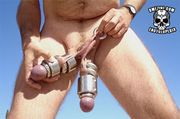Scrotal split
Scrotal splitting is the process of creating a split scrotum, whereby each testicle is contained in it's own separate pouch. Assuming the split is fairly deep, the end effect is that the wearer literally has two scrotums, both visually and functionally. The effect can be extreme (two long, stretched and pierced split scrotums), or mild (a partial split which essentially gives the testicles more visual definition).

Procedure
Scrotal splits are often achieved beginning with a transscrotal piercing which once healed (and possibly stretched as well), a cut (in a DIY context, often after a clamp and cut procedure, although because the tissue is quite thick, crimping effects may be minimal) is made straight down leaving a scrotum that is split up to the top point of the piercing. The exposed tissue on each side is then sutured or otherwise closed. Further cuts and closures can extend the split up to the urethra if desired. If combined with a subincision, the urethra can effectively be exposed all the way back to the site of what would otherwise be a urethral reroute.
A split scrotum that has not been stretched first (see: scrotal stretching) is much more difficult to split because it has a tendency to shorten and pull toward the body (so it looks more like two "bumps" than two distinct scrotums).
Risks
The procedure itself has bleeding risks, as well as infection and specifically scrotal infection whereby an infection is trapped inside the scrotum is able to become serious at a very fast rate. Postoperatively, there are risks of testicular torsion and crushing of the testicles and cords if scarring causes the tissue to contract around the cords, or if the initially available tissue is limited. Saline injections and similar techniques can be used to stretch the scrotum's circumference to minimize this.
Reversal
A scrotum split can be reversed "simply" by opening each inner edge of the split, and suturing it to the other side, restoring the original scrotum (albeit with a few more scars).
